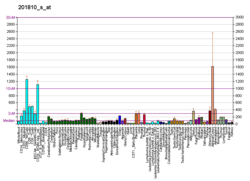SH3BP5
SH3 domain-binding protein 5 is a protein that in humans is encoded by the SH3BP5 gene.[5][6][7]
Interactions
SH3BP5 has been shown to interact with Bruton's tyrosine kinase[5][6] and MAPK8.[8]
References
- 1 2 3 GRCh38: Ensembl release 89: ENSG00000131370 - Ensembl, May 2017
- 1 2 3 GRCm38: Ensembl release 89: ENSMUSG00000021892 - Ensembl, May 2017
- ↑ "Human PubMed Reference:".
- ↑ "Mouse PubMed Reference:".
- 1 2 Matsushita M; Yamadori T; Kato S; Takemoto Y; Inazawa J; Baba Y; Hashimoto S; Sekine S; Arai S; Kunikata T; Kurimoto M; Kishimoto T; Tsukada S (June 1998). "Identification and characterization of a novel SH3-domain binding protein, Sab, which preferentially associates with Bruton's tyrosine kinase (BtK)". Biochem Biophys Res Commun. 245 (2): 337–43. PMID 9571151. doi:10.1006/bbrc.1998.8420.
- 1 2 Yamadori T; Baba Y; Matsushita M; Hashimoto S; Kurosaki M; Kurosaki T; Kishimoto T; Tsukada S (June 1999). "Bruton's tyrosine kinase activity is negatively regulated by Sab, the Btk-SH3 domain-binding protein". Proc Natl Acad Sci U S A. 96 (11): 6341–6. PMC 26883
 . PMID 10339589. doi:10.1073/pnas.96.11.6341.
. PMID 10339589. doi:10.1073/pnas.96.11.6341. - ↑ "Entrez Gene: SH3BP5 SH3-domain binding protein 5 (BTK-associated)".
- ↑ Wiltshire, Carolyn; Matsushita Masato; Tsukada Satoshi; Gillespie David A F; May Gerhard H W (November 2002). "A new c-Jun N-terminal kinase (JNK)-interacting protein, Sab (SH3BP5), associates with mitochondria". Biochem. J. England. 367 (Pt 3): 577–85. ISSN 0264-6021. PMC 1222945
 . PMID 12167088. doi:10.1042/BJ20020553.
. PMID 12167088. doi:10.1042/BJ20020553.
Further reading
- Baba Y, Matsushita M, Matsuda Y, et al. (2000). "Assignment of SH3BP5/Sh3bp5 encoding sab, an SH3 domain-binding protein which preferentially associates with Bruton's tyrosine kinase, to human chromosome 1q43 and mouse chromosome 14B by in situ hybridization.". Cytogenet. Cell Genet. 87 (3-4): 221–2. PMID 10702676. doi:10.1159/000015430.
- Wiltshire C, Matsushita M, Tsukada S, et al. (2002). "A new c-Jun N-terminal kinase (JNK)-interacting protein, Sab (SH3BP5), associates with mitochondria.". Biochem. J. 367 (Pt 3): 577–85. PMC 1222945
 . PMID 12167088. doi:10.1042/BJ20020553.
. PMID 12167088. doi:10.1042/BJ20020553. - Strausberg RL, Feingold EA, Grouse LH, et al. (2003). "Generation and initial analysis of more than 15,000 full-length human and mouse cDNA sequences.". Proc. Natl. Acad. Sci. U.S.A. 99 (26): 16899–903. PMC 139241
 . PMID 12477932. doi:10.1073/pnas.242603899.
. PMID 12477932. doi:10.1073/pnas.242603899. - Ota T, Suzuki Y, Nishikawa T, et al. (2004). "Complete sequencing and characterization of 21,243 full-length human cDNAs.". Nat. Genet. 36 (1): 40–5. PMID 14702039. doi:10.1038/ng1285.
- Brandenberger R, Wei H, Zhang S, et al. (2005). "Transcriptome characterization elucidates signaling networks that control human ES cell growth and differentiation.". Nat. Biotechnol. 22 (6): 707–16. PMID 15146197. doi:10.1038/nbt971.
- Court NW; Kuo I; Quigley O; Bogoyevitch MA (2004). "Phosphorylation of the mitochondrial protein Sab by stress-activated protein kinase 3.". Biochem. Biophys. Res. Commun. 319 (1): 130–7. PMID 15158451. doi:10.1016/j.bbrc.2004.04.148.
- Gerhard DS, Wagner L, Feingold EA, et al. (2004). "The status, quality, and expansion of the NIH full-length cDNA project: the Mammalian Gene Collection (MGC).". Genome Res. 14 (10B): 2121–7. PMC 528928
 . PMID 15489334. doi:10.1101/gr.2596504.
. PMID 15489334. doi:10.1101/gr.2596504. - Wiltshire C; Gillespie DA; May GH (2005). "Sab (SH3BP5), a novel mitochondria-localized JNK-interacting protein.". Biochem. Soc. Trans. 32 (Pt 6): 1075–7. PMID 15506969. doi:10.1042/BST0321075.
- Rual JF, Venkatesan K, Hao T, et al. (2005). "Towards a proteome-scale map of the human protein-protein interaction network.". Nature. 437 (7062): 1173–8. PMID 16189514. doi:10.1038/nature04209.
- Beausoleil SA, Villén J, Gerber SA, et al. (2006). "A probability-based approach for high-throughput protein phosphorylation analysis and site localization.". Nat. Biotechnol. 24 (10): 1285–92. PMID 16964243. doi:10.1038/nbt1240.
This article is issued from
Wikipedia.
The text is licensed under Creative Commons - Attribution - Sharealike.
Additional terms may apply for the media files.





